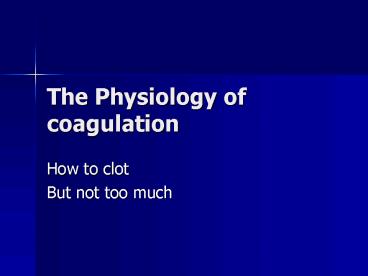The Physiology of coagulation PowerPoint PPT Presentation
1 / 43
Title: The Physiology of coagulation
1
The Physiology of coagulation
- How to clot
- But not too much
2
Basis
- Blood flows through intact vessels
- Resting state is designed to keep blood flowing
- Arteries rapid flow. Injury requires a plug
- Rapid, localised, controlled.
- minimise blood flow compromise
- Veins slower, intermittent flow
- Systemic anticoagulant
- clot dissolving system
3
- Complex activating and inhibition system
- Five components
- Vessels
- Platelets
- Coagulation factors (clot forming)
- Coagulation inhibitors (clot controlling)
- Fibrinolysis (clot dissolving)
4
Haemostasis
- Vasoconstriction
- Platelets activated by thrombin form a platelet
plug - Fibrin mesh forms via activation of the
coagulation system to strengthen the clot - Clot dissolution via plasmin
- Normal blood flow past the clot
5
(No Transcript)
6
(No Transcript)
7
Platelet shape change
- Pseudopod formation
- Interact with adjacent platelets
- Contract later to consolidate the platelet plug
in process of clot retraction
8
Platelet adhesion
- Platelet receptors (integrins)
- Glycoprotein Ib/IX
- Glycoprotein Ia/IIa
- Ligands interact with receptors
- Von Willebrand factor
- Large (high molecular weight) multimers
- collagen
9
(No Transcript)
10
Platelet release reaction
- Stimuli
- Adrenaline, collagen, ADP, thrombin
- Release of preformed active substances from
granules - ADP, serotonin, lysozyme,factor V, thrombospondin
- Activate the prostaglandin pathway
- Thromboxane A2 via cyclooxygenase
- Calcium release
- Glycoprotein IIb/II activation
11
Platelet
Phospholipase A2
Phospholipid
Arachadonic acid
Cyclooxygenase
Endoperoxidases
Thromboxane synthase
Thromboxane A2
Phosphodiesterase
Calcium flux
12
Platelet aggregation
- Platelet receptor
- Glycoprotein IIb/IIIa
- Ligands
- Von Willebrand factor
- Fibrinogen
- IRREVERSIBLE aggregation -gt Plug
13
(No Transcript)
14
(No Transcript)
15
Coagulation forms fibrin mesh
- Biological amplification system which converts
soluble fibrinogen to an insoluble fibrin
meshwork which coverts the primary platelet plug
to a firm, definitive stable clot. - Required local concentration of clotting factors
at site of injury - Surface mediated reactions on exposed collagen,
platelet phospholipid or tissue factor
16
General concepts
- Coagulation factors act as proteases when
activated (serine proteases) - Zymogens (inactive eg fibrinogen) converted to
enzymes/proteins by limited proteolysis - Complex formation requiring calcium,phospholipid
surface, cofactors - Thrombin converts fibrinogen to fibrin monomer
- Fibrin monomer crosslinked to fibrin
- Forms "glue" for platelet plug
17
Cascade effect -gt amplification
Fibrin mesh
2x108mol
1 mol
18
(No Transcript)
19
Coagulation cascade
Intrinsic pathway
XII
XI
Extrinsic pathway
IX
VII
APTT
VIII
X
PT
thrombin
Prothrombin (II)
V, Ca, P/L
fibrin
fibrinogen
XIII
STABILISED FIBRIN
20
INITIATION
IIa (Thrombin)
X
Xa
II (Prothrombin)
21
AMPLIFICATION
22
Fibrinogen -gt fibrin
- Thrombin cleaves fibrinogen
- Fibrinopeptide release
- Fibrin monomers
- Spontaneously link to form a loose polymer
- Fibrin meshwork is stabilised by factor XIIIa
(activated by thrombin and calcium)
23
(No Transcript)
24
Inhibitors ANTI-coagulants
- Antithrombin III
- Directly inactivates serine proteases
- Thrombin and Xa. Also IXa and Xia
- Potentiated by heparin
- Protein C
- Inhibits (cleaves) the cofactors VIIIa and Va
- Significantly decreases the rate of clot
formation - Needs to be activated
25
- Protein S
- Enhances activity of protein C
- Thrombomodulin
- Activated by thrombin
- Binds to thrombin to alter its conformation
- Complex activates protein C
- Tissue pathway factor inhibitor
- Inhibits FVIIa-tissue factor complex
26
Anticoagulants
- Too little or ineffective
- Extensive clot
- Too much
- Bleeding
- Therapeutics
- Heparin
- Activated protein C
- TPFI inhibitor
27
Fibrinolysis
- Prevents excessive fibrin deposition
- Allows closely coupled with fibrin formation
- Localised surface bound phenomenon that is
catalysed by fibrin formation
28
Components fibrinolysis
- Plasminogen -gt plasmin
- Plasminogen activators
- Inactivators of plasminogen
- Inhibitors of plasmin
29
(No Transcript)
30
Effect of plasmin
- Lyses factor V and VIII
- Proteolysis of fibrinogen
- Removes small peptides
- Degradation of fibrin
- Fibrin degradation products (FDP)s
- D-Dimers
31
(No Transcript)
32
Blood Vessel endothelium
- Active
- Haemostasis factors
- Von Willebrand factor
- Tissue factor expressed after injury
- Anticoagulant factors
- ATIII, protein S, thrombomodulin
- Fibrinolysis
- Tissue plasminogen activator
33
(No Transcript)
34
Haemostatic response
- Vasoconstriction
- Initial slowing of blood flow to injured area
- Smooth muscle in arterioles
- Vasoactive substances
- Platelet primary plug formation
- Collagen/VWF
- Glycoprotein Ib/IX and IIb/IIIa
- Aggregation with arachadonic acid pathway
35
Haemostatic response
- Stabilsation of the platlelet plug with fibrin
- Tissue factor activation of coagulation cascade
- Thrombin burst
- Formation of fibrin meshwork
36
Haemostasis reaction
- Regulation of fibrin clot
- Activation of fibrinolysis
- Tissue plasminogen activator
- Plasmin -gt FDPs
37
A test tube is not a person
- Coagulation in vivo
- Temperature
- pH
- Calcium
- That is hypothermic , acidotic, hypocalcaemic
patients dont clot
38
(No Transcript)
39
(No Transcript)
40
(No Transcript)
41
(No Transcript)
42
(No Transcript)
43
(No Transcript)

